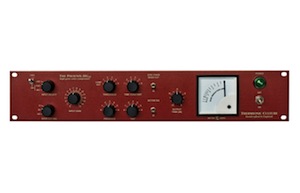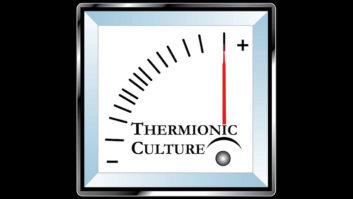
Thermionic Culture is known for producing high-quality pro audio pieces that offer atypical sonic qualities. My first experience in using its gear amazed me at how much I could alter the sound of the source with one device. When I learned the company was building a single-channel unit based on the company’s classic Phoenix stereo compressor, I was interested in running it through its paces. The Phoenix HG15 valve compressor comes with a twist—it includes a preamp with phantom power, variable control settings based off of a Vari-MU design, and limited EQ settings and bass cut to mimic the idea of almost being a full-on channel strip.
Simple Design
The HG15 is a striking two-rackspace, rust-red unit with eight black knobs, three metal switches and a large vintage-style VU meter. Features include input and output detented knobs, a phantom power switch, bass cut and a sidechain to reduce proximity, air and presence switches, and six-position time-constant control designating how much compression is applied. Although I knew it was a tube unit (two valves: 6AQ8EH input and 12AT7/ECC81 output), it wasn’t as heavy as I expected. The build is solid and simplistic; the knobs are made of plastic but feel sturdy to the touch, and I always appreciate the detented knobs for input and output control, which makes for easy recall. The small metal switches are solid but took a minute to get used to, as I had to push them down where most other units are pushed up to engage.
The back panel is even simpler, with single XLRs for input and output, IEC connection for 115/ 230-volt power, and a single phono connection for linking another HG15 for stereo use. The HG15 does not get too hot when in use, so stacking the unit in a rack between other units is not a problem. The input gain/impedance is variable when switching between sources—Mic: 52 dB/1kΩ; Pad: 38dB/2KΩ; Line: 25dB/10k; and the Output Impedance is fixed at 600Ω.
Just a Compressor?
Getting in and out of the HG15 is simple by using the XLR connections provided on the back panel. There are three choices on the front end of the HG15: Mic, Pad and Line. It plays well with most tube and condenser mics, with the additional phantom power supplied. The HG15 maxes out at 52 dB of gain, so a Cloud Lifter or something similar would be helpful to get ribbons or low-impedance mics up to a level that isn’t noisy. I found success using the Pad position with a couple of my tube mics on louder input sources, such as a mono drum mic or electric guitar, whereas the -14dB pad helped the input stage stay smooth and not peak the front end of the compressor. When using the HG15 as a stand-alone compressor either in tracking or mixing, the Line position was the best choice, operating like the original Phoenix compressor but with slightly harder compression.
The compressor design in the HG15 is similar to a Vari-MU or Fairchild 670 with fixed threshold positions, one being minimum, five being maximum. The ratio is not user-definable, as the amount of compression increases toward limiting stages when the input levels increase. The six positions of time-constant control allows for flexibility in the HG15—fast, medium and slow, with variations of that in positions 4, 5 and 6 (1 = F/M, 2 = F/S, 3 = M/ F, 4 = M/M, 5 = M/S, 6 = S/M). Pushing vocals aggressively through the HG15 yielded wonderful results. Additional tone shaping can be applied with variations from the presence and air switches, which will lift midrange and high levels of EQ between 3 kHz and up to 18 kHz. Both can be switched in and out independently or by simply turning on or off the Active EQ switch. The bass cut can be applied to allow signal of the frequency selected to pass without the HG15 applying as much compression, which is helpful when close-miking an acoustic guitar, vocal or guitar cabinet to lessen proximity from the direct source.
Phoenix in Flight
I spent a bit of time getting to know the front panel of the HG15. I was most curious about the sound of the preamp, so I tried a few different input sources for comparisons. The preamp in the mic position is clean and open sounding. It can also be driven hard to emulate the ’60s and ’70s drum sounds that are sampled so heavily today. The HG15 quickly became my “channel strip” of choice for this situation; the combination of the preamp and the compressor added the perfect amount of color to either of the phantom-powered Royer 122 or Fathead II, as well as a Mojave 301 and 201 FET condenser. My Peluso 251 tube required using the pad when recording electric guitar, yet still sounded open and full. Tweaking the amp’s settings just a bit allowed me to not have to apply any EQ. Recording an acoustic guitar with the same mic, I added the EQ switches as I wanted a bit more air for some shimmer above 10k, which worked well.
I enjoyed running bass signals through the HG15, either guitar or a Moog Little Phatty keyboard. I had to use a ¼-inch-to-XLR turnaround to get into the unit, but as long as you have one handy, the HG15 handles bass surprisingly well. Driving the preamp created wonderful fuzz bass tones, and I used the compressor output to control the signal to the DAW.
No matter how aggressive I was with the pre or the compressor, it still sounded useful. The preamp also shined on acoustic guitar and female vocals, and adding the subtle EQ switches and/or bass cut, I was able to find the sound I was looking for. It would be great to have an additional switch that allowed the user to define where the EQ fell in the signal chain, a feature that I enjoyed having on my Pendulum Quartet II channel strip.
On vocals, I could get a wide variety of sonic detail depending on how hard I drove the input side—the two different tubes complement each other nicely. I tend to lean toward medium attack and faster release times when tracking vocals, then a little slower when using a unit as a second compressor to even out the recorded signal. I used it on a female lead vocal for Nashville-based Yumi and the System. The singer wanted her vocal to be slightly gritty, but not sound like a full-on distortion pedal. In each track I was able to vary the tone slightly to help the vocal have a signature sound without being too harsh or over-compressed. Having the preamp and compressor in one unit allowed me to find an even balance of saturation, and the EQ switches helped the vocal cut through the mix with the right amount of presence.
I found myself wanting to switch the meter between input and output to see how hard I was hitting the HG15, but the meter is not selectable, and shows only how much gain reduction is being applied. I learned to listen to the unit and back it off when it was feeling too aggressive for the song. Applying the HG15 on bass when mixing sounded fantastic, as well. The slower release times helped control the bass in the track without sacrificing low end. One of my favorite applications when mixing with the HG15 was to create a mono aux send and send different levels of drum inputs to the aux channel. I would then drive the front end of the HG15 and create some dirt to mix in underneath the dry close mics.
Useful Channel Strip
The Phoenix HG15 from Thermionic Culture fits right in line with the company’s quest for creating products that provide different colors to add to your workflow. It did not describe this unit to me so much as a traditional “channel strip,” but I found myself using as such in many situations. The preamp is of high quality and sounds great on its own. The compressor, based on the company’s original Phoenix stereo compressor, is easy to use, and with the Vari-MU/Fairchild 670 design, the user can apply it with varied degrees of compression up to hard limiting.
Its EQ is simple but very useful when searching for ways to help an individual track sit well in a mix. The only feature I didn’t get to try was linking two HG15s, which could prove to be a powerful stereo pair. If you’re looking for a piece of gear that offers more than you’d expect, the HG15 provides plenty of musical-sounding options for tracking and mixing.
Chris Grainger is a producer/mixer/engineer and owner of Undertow Studio in Nashville.
Product Summary
COMPANY: Thermionic Culture
PRODUCT: Phoenix HG15
WEBSITE:www.thermionicculture.com
PRICE: $2,899
PROS: Great-sounding preamp. Tone-shaping bonus. Easy to link
CONS: No ¼-inch input. No phantom power indicator. Non-switchable metering.
Try This
Use an XLR-to-¼-inch turnaround cable to connect an instrument cable to the HG15. Plug in your favorite bass and drive the input enough to achieve some valve distortion. Apply compression to taste and experiment with the EQ/bass cut switches to allow the low-end to rumble along nicely. Who needs a distortion pedal when you have an HG15?







